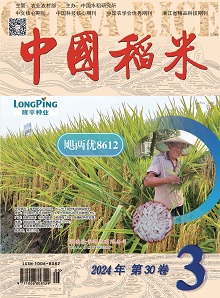The appropriate combination of sowing rate and seedling age is the premise to ensure high yield and high quality of rice. A two-factor split-spot design was adopted, to explore the effects of different seedling ages and sowing rates (T1, 20 day seedling age, 50 g/pot sowing rate; T2, 20 day seedling age, 70 g/pot sowing rate; T3, 30 day seedling age, 50 g/pot sowing rate; T4, 30 day seedling age, 70 g/pot sowing rate) on the seedling quality, yield, and processing quality of machine transplanted indica-japonica hybrid rice Yongyou 6711 seedlings. The results showed that the yield of T2 and T3 treatments was higher, with an increase of 24.7% and 25.2% compared to T1 treatment, and an increase of 17.4% and 17.8% compared to T4 treatment, respectively. Compared with the 20 day seedling age treatments, the 30 day seedling age treatments significantly increased seedling height, stem base width, and aboveground and underground dry matter mass of 100 seedlings; The 70 g/pot sowing rate treatments significantly reduced seedling height, stem base width, and rooting ability compared to the 50 g/pot sowing rate treatments. On the whole, the seedling quality of T3 treatment was the best. In terms of rice processing quality, compared with the 20 day seedling age treatments, the 30 day seedling age treatments significantly reduced the polished rice rate and whole polished rice rate, but had no significant impact on the brown rice rate; Compared with the 50 g/pot sowing rate treatments, the 70 g/pot sowing rate treatments significantly improved the brown rice rate and polished rice rate, but had little effect on the whole polished rice rate. Overall, rice processing quality ofr T2 treatment was the best, while T3 treatment decreased rice processing quality. Therefore, in the medium japonica hybrid rice planting area in northern Jiangsu, the combination of short seedling age and high sowing rate (T2) could achieve high yield and high quality at the same time, while long seedling age and low sowing rate (T3) could achieve high yield, but significantly decreased the rice processing quality.

